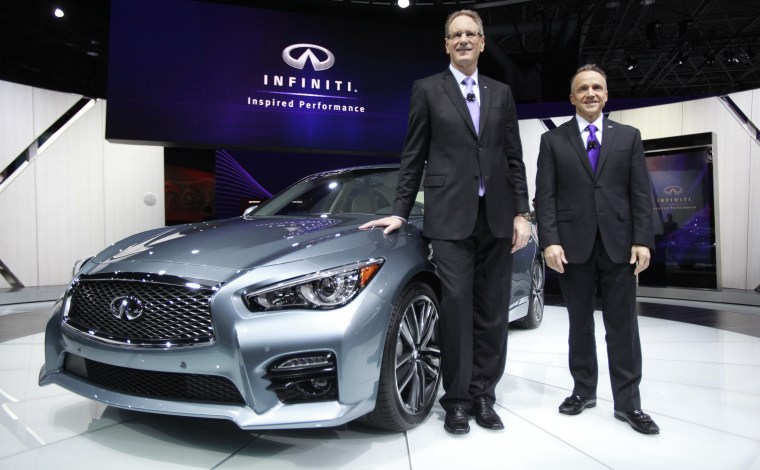With the launch of its new Q50 sedan, Infiniti is steering a new course as it tries to navigate out of the second-tier of luxury brands and take on better-known high-line marques like Mercedes-Benz, BMW and Lexus.
The Q50 replaces the old Infiniti G series and initiates an all-new alphanumeric naming strategy. It also introduces the world’s first steer-by-wire technology, among a variety of other high-tech features being added to the new sedan.
Whether potential buyers take to the new Direct Adaptive Steering system remains to be seen, and analysts warn that Infiniti risks serious confusion as it rebrands existing models to conform to the new nomenclature – something that has caused serious problems for Honda’s Acura and Ford’s Lincoln when they also abandoned more familiar model names.
Read more: Ousted from Volvo, Jacoby Now Will Run GM's Vast International Empire
“We know we’ll face challenges in the short-term but there are tremendous opportunities in the long-term,” said Robb Simmons, Infiniti’s senior marketing manager, during a media preview of the new Q50 line.
Nissan’s luxury division made its debut nearly a quarter-century ago, debuting almost simultaneously with Toyota’s Lexus brand. But Infiniti never quite got the traction of its Japanese rival, as analysts blamed product shortfalls and a curious ad campaign that focused on rocks and trees rather than the maker’s new vehicles.
Read more: Fuel-Saving Stop/Start Technology Migrating to the Masses
Infiniti has gained some momentum, in recent years, with the entry-luxury G series, now its best-selling model line. But while volumes jumped 22 percent in 2012, to 119,877, that was barely half the U.S. total of luxury segment leaders. And Infiniti had virtually no presence outside the U.S. market.
Parent Nissan hopes to change that going forward. It recently reorganized Infiniti as a standalone entity, giving the luxury brand its own design and engineering operations as well as a new headquarters in Hong Kong – where the brand will have a clear view of China. China is expected to become the world’s largest luxury market by decade’s end, according to various forecasts.
Read more: Ford Admits Delaying Recall, Pays $17 Mil Fine
The maker also got a new boss, South African-born Johan de Nysschen, who won kudos during his time as head of the fast-growing U.S. subsidiary of Audi. “My goal is to unlock the potential of this brand,” he told The Detroit Bureau during an interview, even if that means he has to “challenge” the way Infiniti has traditionally done business.
Perhaps the biggest challenge comes from the decision to change the name of Infiniti’s current and future products. Passenger cars will be designated by a “Q,” crossovers and light trucks getting a “QX.”
Read more: Toyota Earnings Nearly Double, Buoyed By Weak Yen, Even as Sales Slip
The new Q50 reaching showrooms in August will be the first all-new model to take advantage of that shift. The sedan is slightly lower, longer and wider than the old G sedan, with a more distinctive grille, sculpted silhouette and the distinctive “crescent” rear pillar first seen on the Infiniti JX – which will be renamed the QX60 which isn’t to be confused with the old QX56 that becomes the QX80.
“There is a risk that the alphanumeric designation becomes a jumble in the minds of consumers,” analyst Joe Phillippi, of AutoTrends Consulting, warns, pointing to the sales stumbles both Acura and Lincoln experienced when they completely revised their own model nomenclatures.
Read more: Jaguar to Unveil 1st-Ever SUV
On the other hand, Phillippi says Acura could get through the challenge with new products that are solid and appealing. The real challenge will be finding a way to “truly differentiate themselves from the rest of the luxury pack. They’ve never quite managed to catch fire and generate a substantial amount of enthusiasm for the brand.”
That’s where the Q50 comes in. The new model is part of the broader Nissan class-above strategy which aims to deliver vehicles that seem a bit more lavish and well-equipped than direct competitors – here including such products as the BMW 3-Series and Mercedes C-Class. Introducing some cutting-edge technology is also part of the strategy.
Read more: Which Brands Will Cost You Most to Keep Fuel in the Tank?
The Q50’s optional Direct Adaptive Steering system makes it the world’s first production car equipped with steer-by-wire which replaces traditional mechanical linkage (though there’s a mechanical backup of power should fail). The system precisely reads driver inputs and, so Infiniti claims, can steer the wheels more quickly than a traditional system. In turn, electronic sensors pass road feel back to the driver – though the three controllers have been designed to tune out unwanted harsh road inputs.
The steer-by-wire system has a lot of potential advantages and also permits the new Q50 to offer an optional lane-holding system that comes a step short of hands-free driving, a camera mounted at the top of the windshield looking for lane markers much like human eyes.
Infiniti officials promise the Q50 will be just one in a rapidly expanding line-up of products to debut over the next few years including one or more so-called “halo” models designed to focus attention on the brand. The Nissan subsidiary also will add a range of new powertrains, such as the hybrid system in the Q50 that is meant to balance performance and fuel economy.
It’s an ambitious goal with potential pitfalls. Indeed, Infiniti officials confirmed last month they will indefinitely delay a luxury battery-electric vehicle based on the mainstream Nissan Leaf’s technology.
For his part, marketing chief Simmons says he’s confident Infiniti can roll out the product. The challenge will be “to make consumers aware of us.” Compounding that challenge is Infiniti’s plan to become a truly global player.
Infiniti has spent more than two decades climbing into the middle of the pack. Challenging the established luxury leaders won’t come quick, both Simmons and de Nysschen agreeing they will need to push hard but maintain their patience.
